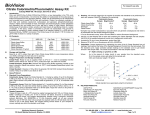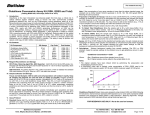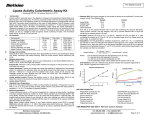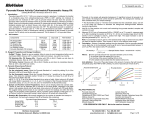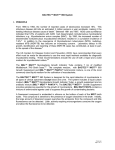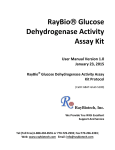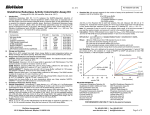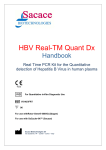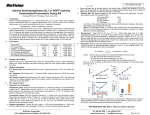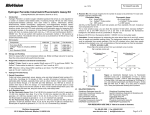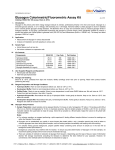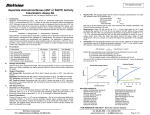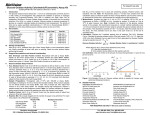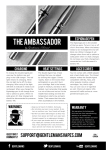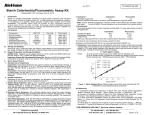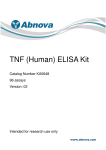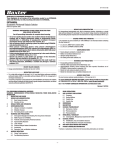Download Data Sheet
Transcript
BioVision For research use only rev. 02/13 FAD Colorimetric/Fluorometric Assay Kit (Catalog #K357-100; 100 assays; Store kit at -20°C) Components FAD Assay Buffer OxiRed Probe (in DMSO) FAD Enzyme Mix (lyophilized) FAD Standard (1 nmol, lyophilized) Stop Solution 100 assays Cap Code Part Number 25 ml 0.2 ml 1 vial 1 vial 1.2 ml WM Red Green Yellow Blue K357-100-1 K357-100-2A K357-100-4 K357-100-5 K357-100-6 III. Storage and Handling: Store the kit at -20°C, protect from light. Allow Assay Buffer to warm to room temperature before use. Briefly centrifuge vials before opening. Read the entire protocol before the assay. IV. Reagent preparation: Probe: Ready to use as supplied. Warm to room temperature to thaw the DMSO solution before use. Store at -20°C, protect from light. Use within two months. Enzyme Mix: Dissolve in 220 µl Distilled Water. Store at -20°C. Use within two months. FAD Standard: Dissolve in 100 µl DMSO to generate 10 pmol/µl (10 µM) FAD Standard. V. FAD Assay Protocol: 1. Standard Curve Preparation: For the colorimetric assay, dilute the 10 pmol/µl FAD Standard solution to 0.2 pmol/µl by adding 10 µlof FAD Standard to 490 µl of Assay Buffer, mix well. Add 0, 2, 4, 6, 8, 10 µl into a series of wells. Adjust volume to 50 µl/well with Assay Buffer to generate 0, 0.4, 0.8, 1.2, 1.6, 2 pmol/well of the FAD Standard. Use a freshly diluted Standard each time. For the fluorometric assay, dilute the FAD Standard solution to 0.02 pmol/µl by adding 10 µl of the 10 pmol/µl FAD Standard to 490 µl of Assay Buffer, mix well. Then take 10 µl to 90 µll of Assay Buffer. Add 0, 2, 4, 6, 8, 10 µl into a series of wells. Adjust volume to 50 µl/well with Assay Buffer to generate 0, 0.04, 0.08, 0.12, 0.16, 0.2 pmol/well of the FAD Standard. 2. Sample Preparations: Homogenize tissue (5 - 20 mg) or cells (1 x 106) in 400 µl of Assay Buffer, centrifuge to remove insoluble material at 13,000 x g for 3 mins. Serum samples should be collected using EDTA to inhibit enzymes that may degrade FAD. Deproteinize sample using perchloric acid precipitation (BioVision, Cat.# K808-200, Deproteinizing Sample Prep Kit) to release FAD from proteins. After deproteinization, add samples directly to 96 well plate, bring the volume to 50 µl/well with Assay Buffer. Approximate sample amount per assay: ~0.1 - 0.5 mg tissue; ~10,000 - 100,000 cultured cells, ~0.1 - 20 µl serum. For unknown samples, we suggest testing several doses of your sample to ensure the readings are within the standard curve range. 3. Reaction Mix: Mix enough reagent for the number of assays to be performed. For each well, prepare a total 50 µl Reaction Mix containing: 46 µl Assay Buffer 2 µl OxiRed Probe* 2 µl Enzyme Mix BioVision Incorporated 155 S. Milpitas Boulevard, Milpitas, CA 95035 USA Add 50 µl of the Reaction Mix to each well containing FAD Standard and test samples. Mix well. * Note: Fluorometric Assay is 10 fold more sensitive than Colorimetric Assay. Using 0.4 µl/well of the probe will significantly decrease the background reading in fluorometric assay. 4. Incubate the reaction at room temperature. 5. Measure OD 570 nm for the colorimetric assay or Ex/Em = 535/587 nm for the fluorometric assay in a micro plate reader. Reading the samples and standards every 5 min. You can stop the reactions by adding 10 µl of Stop Solution; gently shake the plate to mix. The reaction is stable for 24 hr after adding stop solution. Use the data on the time that shows maximum linear readings. The reaction is linear with time until OD 570 nm reaches 1.8 in the colorimetric assays. 6. Calculation: Correct background by subtracting the value derived from the 0 FAD control from all sample readings (The background reading can be significant and must be subtracted from sample readings). Plot FAD standard Curve, FAD concentrations of the test samples can then be calculated: C = Sa/Sv pmol/µl or µM Where: Sa is the sample amount of unknown (in pmol) from standard curve, Sv is sample volume (in µl) added into the wells. FAD Molecular Weight is 785.55 g/mol. 1.5 FAD Fluorometric assay 10000 FAD Colorimetric Assay 8000 1 RFU II. Introduction: Flavin Adenine Dinucleotide (FAD) is a redox cofactor which plays an important role in metabolism. FAD exists in different redox states and cycles between FAD, FADH and FADH2. The primary sources of reduced FAD in eukaryotic metabolism are the citric acid cycle and the beta oxidation reaction pathways. In BioVision’s FAD Assay Kit, FAD functions as the cofactor of an oxidase which catalyzes the formation of a product generating color and fluorescence. FAD can be detected by either colorimetric (OD = 570 nm) or fluorometric (Ex/Em = 535/587 nm) methods. The kit provides a rapid, simple, ultra-sensitive, and reliable test suitable for high throughput assay of FAD. The lower limit of detection is less than 1 nM FAD. Kit Contents: OD 570 nm I. 6000 4000 0.5 y = 0.6976x + 0.0315 R² = 0.9994 y = 45285x + 835.62 R² = 0.9996 2000 0 0 0 0.5 1 1.5 FAD (pmol/well) 2 0 0.05 0.1 0.15 0.2 FAD (pmol/well) FAD Standard Curve. Assays were performed following this protocol, reading after 15 min incubation. RELATED PRODUCTS: NAD/NADH Quantification Kit ADP/ATP Ratio Assay Kit Glucose Assay Kit Ethanol Assay Kit Pyruvate Assay Kit Creatinine Assay Kit Hemin Assay Kit Total Antioxidant Capacity (TAC) Assay Kit NADP/NADPH Quantitation Kit Ascorbic Acid Quantification Kit Fatty Acid Assay Kit Uric Acid Assay Kit Lactate Assay Kit/ II Triglyceride Assay Kit Glutathione Detection Kit Nitric Oxide Assay Kit FOR RESEARCH USE ONLY! Not to be used on humans. Tel: 408-493-1800 | Fax: 408-493-1801 www.biovision.com | [email protected] Page 1 of 2 BioVision rev. 02/13 For research use only GENERAL TROUBLESHOOTING GUIDE: Problems Cause Solution Assay not working • Use of ice-cold assay buffer • Assay buffer must be at room temperature Samples with erratic readings Lower/ Higher readings in Samples and Standards Readings do not follow a linear pattern for Standard curve Unanticipated results • Omission of a step in the protocol • Refer and follow the data sheet precisely • Plate read at incorrect wavelength • Check the wavelength in the data sheet and the filter settings of the instrument • Use of a different 96-well plate • Fluorescence: Black plates ; Luminescence: White plates ; Colorimeters: Clear plates • Use of an incompatible sample type • Refer data sheet for details about incompatible samples • Samples prepared in a different buffer • Use the assay buffer provided in the kit or refer data sheet for instructions • Samples were not deproteinized (if indicated in datasheet) • Use the 10 kDa spin cut-off filter or PCA precipitation as indicated • Cell/ tissue samples were not completely homogenized • Use Dounce homogenizer (increase the number of strokes); observe for lysis under microscope • Samples used after multiple free-thaw cycles • Aliquot and freeze samples if needed to use multiple times • Presence of interfering substance in the sample • Troubleshoot if needed, deproteinize samples • Use of old or inappropriately stored samples • Use fresh samples or store at correct temperatures till use • Improperly thawed components • Thaw all components completely and mix gently before use • Use of expired kit or improperly stored reagents • Always check the expiry date and store the components appropriately • Allowing the reagents to sit for extended times on ice • Always thaw and prepare fresh reaction mix before use • Incorrect incubation times or temperatures • Refer datasheet & verify correct incubation times and temperatures • Incorrect volumes used • Use calibrated pipettes and aliquot correctly • Use of partially thawed components • Thaw and resuspend all components before preparing the reaction mix • Pipetting errors in the standard • Avoid pipetting small volumes • Pipetting errors in the reaction mix • Prepare a master reaction mix whenever possible • Air bubbles formed in well • Pipette gently against the wall of the tubes • Standard stock is at an incorrect concentration • Always refer the dilutions in the data sheet • Calculation errors • Recheck calculations after referring the data sheet • Substituting reagents from older kits/ lots • Use fresh components from the same kit • Measured at incorrect wavelength • Check the equipment and the filter setting • Samples contain interfering substances • Troubleshoot if it interferes with the kit • Use of incompatible sample type • Refer data sheet to check if sample is compatible with the kit or optimization is needed • Sample readings above/below the linear range • Concentrate/ Dilute sample so as to be in the linear range Note: The most probable list of causes is under each problem section. Causes/ Solutions may overlap with other problems. BioVision Incorporated 155 S. Milpitas Boulevard, Milpitas, CA 95035 USA Tel: 408-493-1800 | Fax: 408-493-1801 www.biovision.com | [email protected] Page 2 of 2


